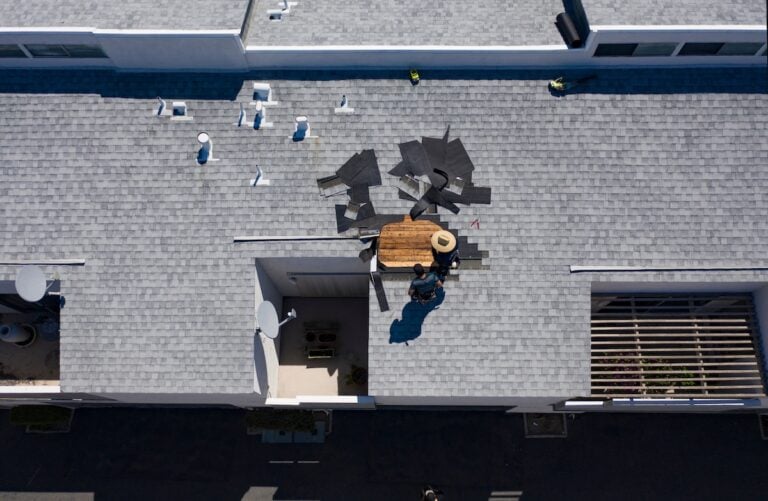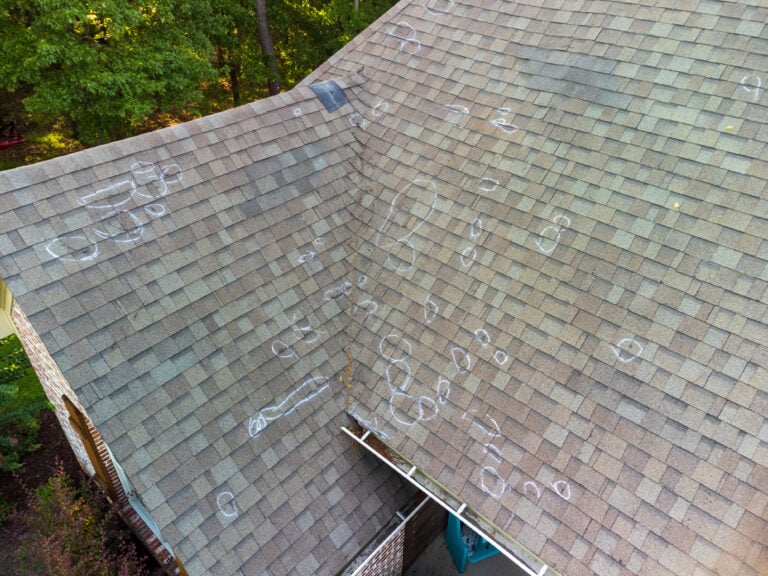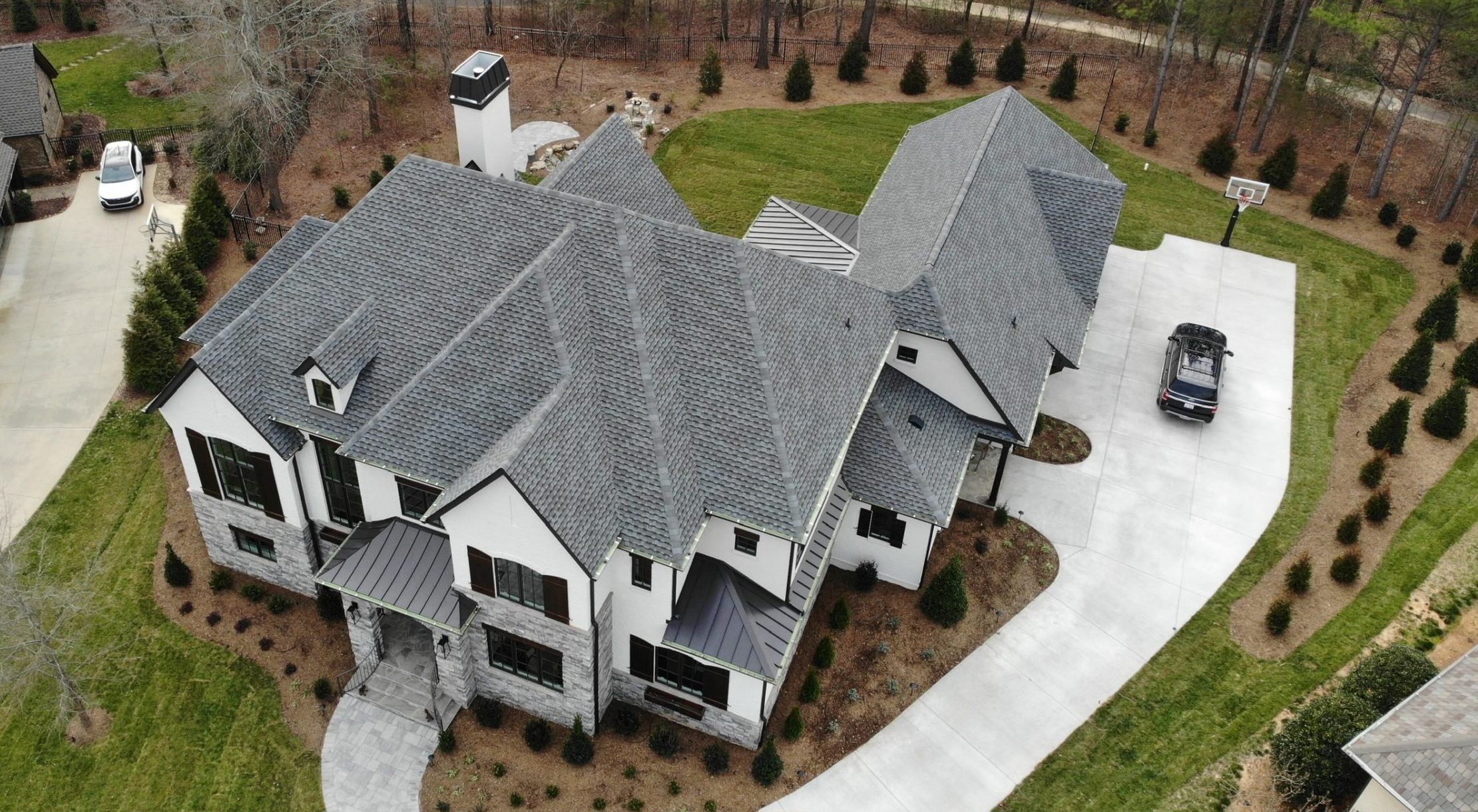Roof Flashing: 5 Common Types for Your Roof + Benefits
Posted 5.21.25 | 7 Minute Read

Roof flashing plays a vital role in protecting your home from water damage. If you’ve never given much thought to the term “roof flashing,” don’t worry, you’re not alone. However, understanding what it is and why it’s important could save you from costly repairs in the future.
This blog offers a comprehensive guide to roof flashing. Here’s what we’ll cover:
- What is roof flashing?
- Common types of roof flashing, and when to use them
- Why choosing the right roofing contractor matters
🤔 What Is Roof Flashing?

Roof flashing refers to thin pieces of metal or other durable material installed to direct water away from vulnerable areas of a roof. It’s commonly found around chimneys, vents, skylights, and intersections where two slopes meet. Properly installed roof flashing ensures water flows into the gutters instead of seeping into cracks or crevices, keeping your home safe and dry.
Benefits of Roof Flashing
Investing in quality roof flashing comes with several benefits. Here’s why it’s an essential component of your roofing system:
- Waterproofing Protection: Roof flashing acts as a first line of defense, preventing water intrusion in critical areas.
- Extends Roof Lifespan: By diverting water away, flashing helps to prevent leaks, rot, and mold, thus extending the life of your roof.
- Prevents Structural Damage: Without proper flashing, water can leak into your home, causing damage to walls, ceilings, and insulation.
- Cost-Effective Maintenance: Repairing a roof with flashing damage is simpler and less expensive than addressing widespread water damage.
⭐️ 5 Common Types of Roof Flashing

When it comes to roof flashing, one size does not fit all. Here are some of the most common types and their uses:
1. Step Flashing
Step flashing is a critical component of roofing, designed to protect the areas where the roof meets a vertical wall, such as the side of dormers, chimneys, or other structures. It consists of small, individual pieces of metal installed in a step-like pattern, with each piece overlapping the next. This interwoven design ensures water is directed away from vulnerable intersections, preventing leaks and water damage. By integrating step flashing with shingles, water is effectively channeled downward, following a controlled path to the gutters. One of the key advantages of step flashing is its ability to handle small shifts in the roof structure over time, maintaining its waterproof seal. Proper installation is essential, as even minor gaps or misalignment can lead to significant water damage. This type of flashing provides long-term durability and peace of mind, especially in areas of the roof that are prone to heavy water runoff.
2. Continuous Flashing
Continuous flashing, often referred to as “apron flashing,” serves as a seamless solution for protecting longer stretches of roof where it intersects with vertical walls or surfaces. Unlike step flashing, which uses multiple pieces, continuous flashing is a single, unbroken strip of metal that directs water downward toward the roof shingles. This uninterrupted design is particularly useful for areas where aesthetics and functionality are equally important. However, because the metal used in continuous flashing is exposed to temperature fluctuations, it’s essential to allow for expansion and contraction. Without this flexibility, the flashing could warp or crack over time, compromising its effectiveness. Regular maintenance and inspection can help ensure it remains secure and weatherproof. Continuous flashing is not only practical but also offers a clean, professional appearance, making it a popular choice for modern roof designs.
3. Valley Flashing
Valleys, where two roof slopes meet to create a trough, are among the most vulnerable areas of a roof. These natural water channels manage significant volumes of rain or melting snow, making them prone to leaks if not properly protected. Valley flashing is specifically designed to safeguard these critical areas. Typically made from durable materials like aluminum, galvanized steel, or copper, valley flashing reinforces the roof’s weakest points by ensuring water flows efficiently into gutters instead of seeping into the structure. Proper installation of valley flashing involves securing it beneath the shingles, with an exposed center portion to direct water. This design prevents pooling, reduces the risk of leaks, and extends the lifespan of the roof. For homes in regions with heavy rainfall or snow, valley flashing is an indispensable feature, offering both performance and reliability under challenging weather conditions.
4. Drip Edge Flashing
Drip edge flashing is a small yet powerful component of any roofing system, installed along the edges of the roof to protect against water-related damage. Its primary function is to direct water away from the fascia board and other vulnerable areas of the roofline. This simple addition prevents rainwater from trickling down the edges of the roof and causing wood rot, mold growth, or structural damage over time. Beyond its functional benefits, drip edge flashing also improves the appearance of the roof by creating a clean, polished edge that enhances curb appeal. Made from materials like aluminum, galvanized steel, or copper, drip edge flashing is resistant to rust and corrosion, ensuring long-term durability. Whether you’re upgrading your roof or installing a new one, drip edge flashing is a must-have feature for protecting your investment and maintaining the integrity of your home.
5. Counter Flashing
Counter flashing is a crucial element of roof waterproofing, providing an additional layer of protection around high-risk areas such as chimneys, skylights, vents, and other roof penetrations. It works in tandem with base flashing, overlapping it to create a double barrier against moisture. This layered system prevents water from seeping behind the flashing and entering the roof structure, which is particularly important in areas prone to heavy rainfall or snow accumulation. Counter flashing is typically made from durable materials like aluminum, copper, or stainless steel, ensuring it can withstand harsh weather conditions over time. Its installation often involves embedding the flashing into masonry or other vertical surfaces, creating a watertight seal. For homeowners, counter flashing offers peace of mind by reinforcing the roof’s most vulnerable points and reducing the risk of costly water damage. Properly installed counter flashing is a long-term solution that adds both functionality and value to your roofing system.
⚖️ Why Choose the Right Roofing Contractor

Selecting a trustworthy contractor is just as crucial as choosing quality flashing materials. Poor installation can undermine even the best flashing, leaving your home vulnerable to leaks and damage.
At Great State Roofing, we take pride in providing professional craftsmanship and reliable service. Here’s why homeowners trust us:
Expert Team
Our team of certified professionals brings years of experience in installing and repairing roof flashings. Whether it’s a minor repair or a complete flashing replacement, you can trust our experts to deliver precision and quality workmanship every time.
Top-Quality Materials
We believe in using only premium materials to ensure your roof flashings provide durable, long-lasting protection. By combining superior products with expert installation, we help safeguard your home against leaks and weather damage for years to come.
Transparent Communication
From the initial inspection to the final installation, we prioritize clear and open communication. You’ll be informed about every step of the process, so you understand what’s happening with your roof and can make confident decisions along the way.
Community Commitment
Proudly serving Charlotte, Rock Hill, Greensboro, and the surrounding areas, we are dedicated to providing exceptional service to our community. Our goal is to build lasting relationships with homeowners by ensuring every project is completed to the highest standard.
🏠 Roof Flashing Guide
At Great State Roofing, we understand that quality roof flashing is essential to protecting your home from water damage and ensuring long-lasting durability. Our experienced team delivers expert craftsmanship and attention to detail, treating every project as if it were our own home.
Whether you need a thorough inspection, a quick repair, or a full installation, you can trust us to get the job done right. Don’t leave your roof to chance—contact Great State Roofing today for reliable, stress-free service you can count on. Call us or reach out here to get started!






